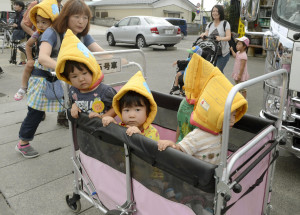I became interested in emergency preparedness when I was pregnant with my first child. I could handle my own mortality, but my child’s? No way. These days I think about all children, not just my own. Lately I’ve been asking childcare providers in my community what they’re doing to prepare for an earthquake. Read on to see what a few of them have told me. If you have concerns about your child’s facility not being prepared, consider sharing this info with them.
 PHYSICAL PREPARATION
PHYSICAL PREPARATION
- Consider having your facility retrofitted, and make sure water heaters are strapped to the wall.
- Secure top-heavy furniture with brackets or straps, cabinet doors with latches, and smaller items that could fall with museum putty.
- Make sure all staff know how to shut off electricity, gas, and water. Make sure staff are aware if there is an asbestos situations that would necessitate evacuation.
- Have all of the same preparedness supplies as a regular home, plus food/water reserves to last several days or weeks for all children and staff. Visit the Portland Bureau of Emergency Management’s Preparedness Resources page for detailed information about how to make plans and build kits.
- Have provisions for sheltering in place outside the facility (back yard), in a hazard-free area nearby (park, etc.), and a location further afield (if a toxic situation arises near the facility).
- Have parents prepare a “comfort kit” for their child, and add a space blanket, poncho, and dust mask to each one.
COMMUNICATION
- Conduct drills frequently. Make sure everyone knows the drill: drop, cover, hold. Identify a safe gathering space outside for after the shaking stops.
- Communicate with families several times a year about this issue. Make it clear to them that you will do your best to care for children until they can arrive, but they should have backup plans in place for someone else to pick up their children in case they are unable to get to the facility.
- Have hard copies of all parent information, including work address and emergency medical forms, ready to go with you once the shaking has stopped. Have an out-of-state (non-West coast) contact number for you and families to use as a point of contact for updates, as local numbers will not go through.
- Encourage families to discuss earthquake safety at home and prepare their own kits.
- Be prepared to deal with the children’s emotions after an earthquake. They will be scared and need lots of reassuring. Use physical reassurance (hugs), and make sure they understand that you will take care of them until their parents arrive.
- Keep in touch with your local Neighborhood Emergency Team so that you know what they’re planning, and consider Other Ways to Prepare.
TRAINING
- Consider getting NET training for you and your staff. NET volunteers know how to do light search and rescue, basic disaster medicine and triage, radio communications, fire suppression, disaster psychology, and trauma intervention.
For a more in-depth look at childcare facility preparedness, read Multnomah County’s Child Care Center Crisis / Disaster Response Handbook. This is an excellent tool that covers most of what a facility would need to be prepared.
–Laura Hall, Arbor Lodge / Kenton NET Assistant Team Leader, arborlodgeprepares@gmail.com
